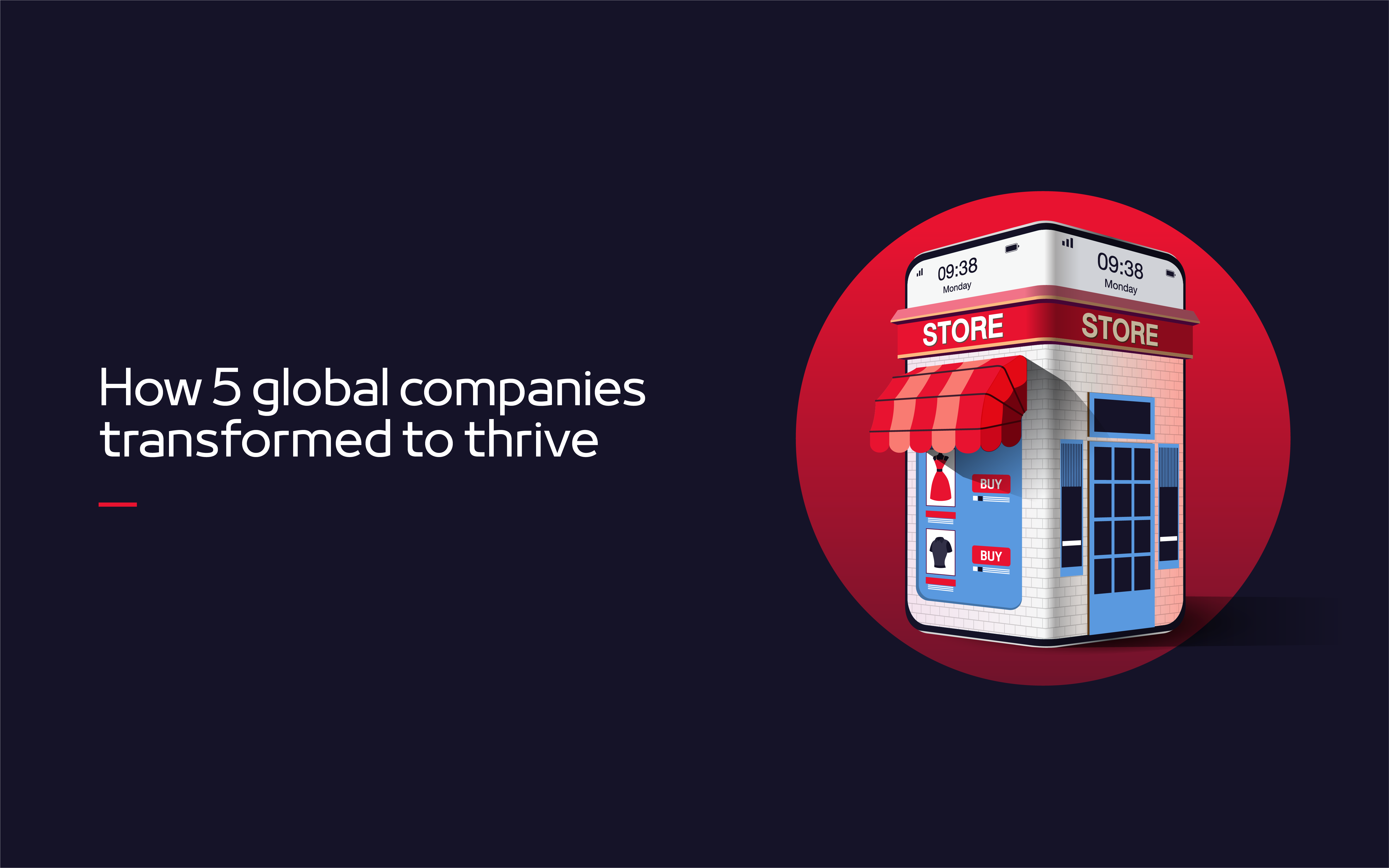
How 5 Global Companies Transformed to Thrive
Learn how major companies thrived by adapting to change
Change is the only constant. This statement holds very true for the world of business, and that’s why adapting to change is a vital skill and tactic for businesses and individuals alike. Running a business comes with unexpected challenges; there is no way of telling the next big trend that could render some of your products and services obsolete, or a major global event that could change the lives of people and how they engage with businesses or a wave of accelerating technology advancements that alter the expectations of your customers. Organizations of all sizes need to be prepared for change and ensure that adaptability is at the center of their strategies to continue to thrive and grow. Here are some examples of prominent companies that adapted to change, not only to survive and grow, but also disrupt the sectors they are within:
- Netflix
Netflix revolutionized the movie and television industry when giants within it were still trying to preserve their traditional business models. The company started as a DVD by mail service in the 1990s, however, when the DVD market started shrinking, CEO Reed Hastings had the vision to start streaming services to offer movies directly over the internet to customers. Netflix invested significant amounts to develop new streaming technologies and launch its new streaming service “Watch Now” in 2007.
This foresight led them to become the first streaming success story with roughly 214 million global subscribers. Very few currently own a DVD player, but almost everyone has recently binge watched a Netflix original series. That’s another area where Netflix identified an opportunity to adapt and grow by adding a production company to their business and create original content to cater to the ongoing demand for new and diverse content and reduce the costs of content licensing. While Netflix is a great example of capitalizing on tech trends and user behavior to adapt business models, stay relevant, and achieve success, change struck again with news surfacing of Netflix losing over 200,000 subscribers in the first quarter of the year.
- Western Union
Western Union was established in the 1800s as a printing and telegraph company. For the first 15 years, most of their work was focused on sending telegrams. However, as telegraphy started getting replaced by other methods of communication, the company diversified to offer more service lines, including a money order service. Western Union was able to grow rapidly within the money transfer industry, expanding internationally and revolutionizing international remittances. The company continued to innovate and provide , such as introducing consumer credit cards and facilitating bill and loan payments for their customers. Western Union sets a 169-year long example of dynamism and adaptability, staying abreast of the latest tech trends to meet market demands and succeed.
Very few would recognize Instagram’s original business name “Burbn”, an app that offered a combination of games and location check-in features. To distinguish their app from then popular check-in app Foursquare and build on their most used feature, which was photo sharing, the founders opted to reduce features and offer only the ability to post, comment and like. And that’s how Instagram was born, becoming one of the biggest successes in tech at the time and getting acquired by Facebook for $1 billion only 2 years later.
Instagram has over 1 billion users and has continued to grow and transform in a highly competitive industry over the years by bringing the latest trends in social media to users such as introducing stories and reels in response to the increasing popularity of Snapchat and TikTok, to stay relevant and maintain its popularity.
- Amazon
Amazon started as an online bookseller in 1994, but Jeff Bezos had big plans from the onset of his business venture as he insisted it is a technology company, not a retailer. Within 5 years Amazon was selling much more than books, the company expanded to international markets and was selling electronics, video games, toys, music, videos and more. Over the years Amazon set an example of adapting to ongoing market demands to become the tech behemoth it is today, valued at over $400 billion and ranked as the fifth largest company in the world.
Amazon started with a promise to deliver any book to any reader anywhere and has since then revolutionized retail over the internet reshaping the concept of convenience for customers. The company didn’t stop at books or other retail products, but ventured into introducing their own e-reader, the Kindle, creating e-books, selling fresh groceries online and opening their own grocery stores. In 2002, the company launched Amazon Web Services (AWS) which initially offered data and statistics on internet usage and websites, and currently is the lead cloud computing platform controlling over a third of the market and contributing 13% of Amazon’s total revenue. With their customer-centric approach Amazon continuously reinvented themselves to grow and expand rapidly and stand the test of change, pushing the borders of innovation every step of the way.
- Zoom
Zoom shows us that your transformation doesn’t necessarily have to be a response to your business struggling, but rather by capitalizing on opportunities presented by current events to achieve growth and expansion. With the onset of the global pandemic, Zoom immediately noticed the impact of this global event and started making changes, suspending their 40-minute time limit for some users in the affected areas in China and sharing content about working from home. In a few months, Zoom surpassed the competition with 300 million daily meeting participants, a surge the company attributed to the platform’s ease of use, attractive features, marketing efforts, and the ability to host and join meetings for free.
Over the next period Zoom had to accommodate the rapidly growing demand while also facing lockdown and work-from-home restrictions themselves. To cater to the increasing number of meetings and users, the company invested in cloud services when their data centers couldn’t carry the load. As the platform gained popularity and more people were hosting their meetings and events on Zoom, the company faced criticism on the quality of their privacy and security, to which the CEO responded by dedicating a 90-day period focusing only on privacy and security and freezing work on new features. This showcased their dedication to solving the customers’ problems and prioritizing their needs. COVID-19 greatly accelerated the need for digital collaboration tools, and Zoom was ready to take the lead in this area, gaining enough popularity to turn their brand name into a verb.
When adapting is the only choice
While these are valuable lessons learned from history, one can’t talk about adapting to change without looking at the transformations that were made necessary by the global pandemic. COVID-19 created a situation where businesses were forced to adapt or pivot to survive. The worldwide crisis affected companies of all sizes and across all sectors. And when many companies found themselves on the brink of shutting down, some great examples rose to the challenge, making highly successful pivots that ensured not only their survival but, in some cases, provided opportunities for growth.
Among the sectors highly affected by the pandemic was the air travel industry. There was a significant drop in commercial passengers that led airlines to cancel up to 90% of their scheduled flights. This is where some large airlines such as Virgin Atlantic, Lufthansa, United and American airlines, found an opportunity to offer cargo transfer using the empty passenger cabins to fill the gap of transporting necessary items.
As working from home became the norm, many employees found themselves lacking the space they needed to be productive and fulfill their job requirements. On the other hand, hotels struggling with low occupancy rates, also a side-effect of the pandemic, thought to capitalize on this situation and offer day rates for work from home employees to rent the spaces they required for their workdays. Offering low prices and convenient spaces for remote workers provided hotels with an income stream where there would have been none for lack of travel and demand on hotel bookings during the pandemic.
With quarantines and social distancing measures in place, empty grocery stores became the ideal fulfillment centers, allowing these businesses to continue to provide their products to customers in need. Several grocery brands such as Kroger and Whole foods adopted the “Dark shops” approach and turned some of their shops into fulfillment centers so they can fill pickup and delivery orders quickly and conveniently due to proximity to customers.
Between past and present, these examples and stories give one key takeaway: adaptability is crucial for business continuity. It’s important for enterprises of all sizes and across all economic sectors to adopt a culture of flexibility and dynamism, while also embracing technology and innovation to achieve sustainability for their businesses.

